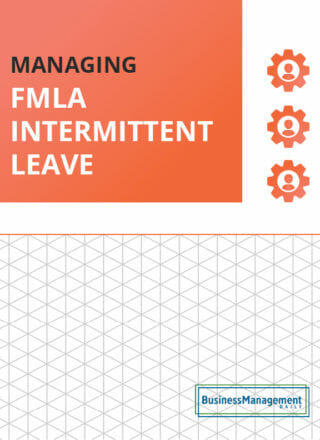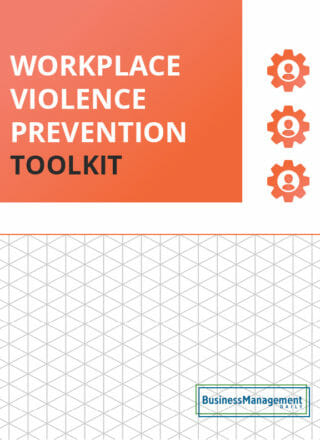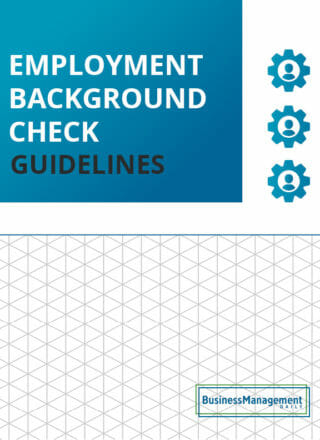Preventing retaliation in the workplace
 The basics of workplace retaliation
The basics of workplace retaliation
The fear of workplace retaliation makes many workers who experience or witness discrimination, harassment, safety violations, or other unacceptable actions afraid to come forward. This trepidation can lead to undesirable outcomes, including poor behavior, lowered morale, increased stress, and higher turnover rates.
In general, “retaliate” means getting back at someone. After person one does something person two does not like, the latter issues a punishment or other adverse consequence.
The same basic principle applies to workplace retaliation (sometimes called employer retaliation), though the terminology gets more complex.
What is workplace retaliation?
According to the U.S. Department of Labor (DOL), “Retaliation occurs when an employer (through a manager, supervisor, administrator, or directly) fires an employee or takes any other type of adverse action against an employee for engaging in protected activity.”
What might constitute a protected activity? Common examples include:
- Filing a discrimination complaint or harassment complaint
- Participating in an investigation of discrimination or harassment
- Reporting work environment safety violations
- Taking protected medical leave, such as FMLA (Family and Medical Leave Act)
- Seeking reasonable accommodations under the Americans with Disabilities Act
Who is protected from retaliation?
Victims and concerned co-workers can engage in what is considered protected activity. For instance, many federal and state laws prohibit discrimination based on race, color, national origin, age, religion, disability, gender, or sexual orientation.
They also prohibit retaliation against individuals who oppose unlawful discrimination or participate in an employment discrimination proceeding.
Sometimes, employer retaliation happens without an “official” complaint. Consider a worker experiencing sexual harassment. She might decide to inform her manager about a colleague’s unwanted advances.
She might choose this instead of going to human resources. Or, she might also choose this instead of seeking legal action. However, the manager might then try to silence her. The manager might give her a poor performance review. This constitutes retaliatory behavior.
As the U.S. Equal Employment Opportunity Commission (EEOC) noted, “Participating in a complaint process is protected from retaliation under all circumstances.
Other acts to oppose discrimination are protected as long as the employee was acting on a reasonable belief that something in the workplace may violate EEO laws. Even if they did not use legal terminology to describe it.”
What does workplace retaliation look like?
Now, let’s explore another critical element of the definition of retaliation – adverse action (sometimes called materially adverse action).
The DOL says an adverse action is “an action which would dissuade a reasonable employee from raising a concern about a possible violation or engaging in other related protected activity.”
Examples of adverse actions employers might enact as retaliation include:
- Deny a promotion
- Demotion
- Suspension
- Termination
- Salary reduction
- Transfer to a different department or office
- Cut work hours
- Eliminate perks such as use of a company car
- Negative performance review
- Excessive micromanagement
- Exclude from meetings or opportunities
- Make the work environment unsafe or uncomfortable
- Alert a worker’s future employers to the complaints when they call to check references
- Threaten deportation
- Confiscate a worker’s passport or other immigration documents
- Intimidation
- Blacklisting
Is it actually workplace retaliation?
According to the EEOC, in a case alleging that an employer took materially adverse action because of protected activity, legal proof of retaliation requires evidence that:
- An individual engaged in prior protected activity.
- The employer took a materially adverse action.
- Retaliation caused the employer’s action.
Understanding these three factors is critical. The first two elements should seem obvious to most people considering a retaliation claim, but the last bears further consideration.
Many of the actions employers might take to retaliate are also part of everyday business life without prior complaints playing any role. Companies sometimes need to cut staff.
Workers failing to live up to performance expectations receive unfavorable annual evaluations. Rulebreakers receive discipline by company policy.
Employees who file a claim with the EEOC or another agency should remember an important point. Filing a claim does not give them a free pass. It does not allow them to neglect their job duties.
Furthermore, it does not allow them to violate employer rules. Employers are entitled to discipline or terminate them for poor performance or improper behavior.
The question often becomes, “Which is it – employer retaliation or an employer dealing with situations as it would for any employee?”
EEOC guidelines list these types of evidence as possibly supporting a claim of retaliation:
- Suspiciously close timing between the EEO activity and the materially adverse action.
- Verbal or written statements demonstrating a retaliatory motive, comparative evidence (e.g., the individual was disciplined for an infraction that regularly goes undisciplined in that workplace, or that another employee who did not engage in EEO activity committed and was not punished as severely).
- Demonstrated falsity of the employer’s proffered reason for the adverse action.
- Any other pieces of evidence viewed alone or in combination with different facts may support an inference of retaliatory intent.
Employees who believe retaliation is the cause should document events. Details about what happened, when, witnesses, and the like will help the complaint process. If consulting an employment lawyer, this information assists the professional in offering legal advice.
Employers should do the same from their perspective. Not every negative employment action experienced by a claimant is retaliation. Demonstrate valid reasons for taking specific actions.
Laws and agencies
Various state and federal laws offer workers protection against retaliation. The nature of the original offense determines which government entity handles retaliation complaints.
The EEOC enforces federal laws. These laws make it illegal to discriminate against a job applicant or an employee based on race, color, religion, sex, national origin, age, disability, or genetic information.
Specifically, sex includes pregnancy, childbirth, or related conditions, gender identity, and sexual orientation. Age discrimination applies to those 40 or older.
Some notable EEO laws include:
- Title VII of the Civil Rights Act of 1964
- Equal Pay Act of 1963
- Americans with Disabilities Act (ADA)
- Pregnant Workers Fairness Act of 2022
To learn more about filing a retaliation complaint with the EEOC, federal government employees can visit: https://www.eeoc.gov/federal-sector/overview-federal-sector-eeo-complaint-process.
Other workers can visit: https://www.eeoc.gov/how-file-charge-employment-discrimination.
The DOL’s Wage and Hour Division is responsible for administering and enforcing several federal laws about basic labor standards. It protects people from retaliation for reporting issues relating to things such as:
- Minimum wage
- Overtime pay
- Recordkeeping
- Youth employment
- Agricultural work
- Family and medical leave
- Lie detector testing
For info on filing a complaint of this nature, see https://www.dol.gov/agencies/whd/contact/complaints.
Another DOL agency, the Occupational Safety and Health Administration (OSHA), deals with problems related to workplace conditions, hazards, and violations.
It also enforces the Whistleblower Protection Program, which prohibits employers from retaliating against employees for exercising their rights under the Occupational Safety and Health Act.
View https://www.whistleblowers.gov/complaint_page for more on how to file a whistleblower complaint.
Employee considerations about reporting retaliation
Deciding whether or not to report retaliation is a highly personal matter. Each potential victim or witness needs to weigh the pros and cons.
For many individuals, reporting feels like the right thing to do. Doing so makes a statement about employee legal rights and workplace justice. It gives them a greater sense of control in an unfortunate situation and may prevent retaliation from happening to others.
Being called into question also has the potential for the retaliatory behavior to stop. The prospect of an investigation may lead an employer to rectify, such as by dropping disciplinary procedures or rewriting a performance appraisal.
Sometimes, claimants receive compensation for damages, such as back pay or payment for emotional distress. The employer may decide to reinstate someone who has been terminated or demoted to her former position.
However, some individuals decide not to report retaliation. They may fear further retaliatory actions or job loss. They may deem the process as too lengthy and stressful. And if the case requires legal representation, they may worry about cost.
The impact of retaliation
Adverse actions by the employer affect the person to whom they happen. Retaliation can feel like adding insult to injury. It can harm livelihood, career prospects, and physical and mental well-being.
Colleagues may also suffer. For example, they may sympathize with the victim of retaliation and find it hard to trust their employer.
Additionally, they may feel too scared to speak up about workplace discrimination or other issues, which can prevent them from reporting misconduct they witness.
Wise employers know that retaliation can have potentially damaging consequences for the organization. For starters, retaliation claims can lead to lengthy, costly legal action.
Then, there’s the problem of employees no longer buying into the idea of “See something, say something.” Their trepidation over punishment for being a “snitch” allows bad behavior to continue and minor problems to develop into larger ones.
Retaliation also leads to a loss of respect. The victim may seek employment elsewhere, and colleagues may, too. A toxic environment with plummeting morale does not bode well for retaining top talent.
Disgruntled employees pass along information to their network and air grievances on job review sites, which can lead to recruitment problems. Job applicants also become leery of places with a bad reputation.
Preventing retaliation
Just how pervasive are retaliation complaints? The EEOC reports that 56% of its claims in 2021 were retaliation claims.
Ideally, workplaces would be free of discrimination, harassment, misconduct, unsafe conditions, and any other sources of complaints. Without these things, employees would not need to make claims, reducing the possibility of retaliation. Practical anti-retaliation efforts provide a viable option instead of this best-case scenario.
Success begins with constructing company anti-retaliation policies. Clearly define workplace retaliation, with examples of its possible forms.
Publish the policy in the employee handbook and go over it during onboarding. The document should encourage workers who suspect they might be victims to come forward. Provide details of how to report incidents and to whom.
Offer multiple communication methods, including anonymous channels, to help people feel comfortable.
Provide regular training for human resource staff members on handling retaliation claims and hold separate educational sessions for managers on the topic.
Make it clear that retaliation is unacceptable and subject to disciplinary measures. Stress that preventing retaliation is good for workers and good for the business.
Some things to keep in mind when crafting policies and educating those responsible for enforcement:
- Policies should not discourage employees from reporting concerns to a government agency or require employees to report problems to the employer first.
- Consider confidentiality a top concern.
- Take all retaliation claims seriously and address them promptly.
- Keep those who report updated as much as possible regarding investigations.
- Include a follow-up process to ensure no further retaliatory behavior is occurring.
Finally, foster an organizational culture that values sharing information without fear of retaliation. Bringing issues to light early enables addressing them before they become more challenging to resolve.
Promote the idea that everyone plays a role in establishing a safe workplace. This workplace should be both physically and psychologically safe. Furthermore, it emphasizes that the company supports responsible behavior from its employees.
Additional resources:
FMLA retaliation — what employers need to know ![]()
The DOL’s new guidance on unlawful retaliation ![]()
Workplace etiquette: The ultimate guide to professionalism ![]()





